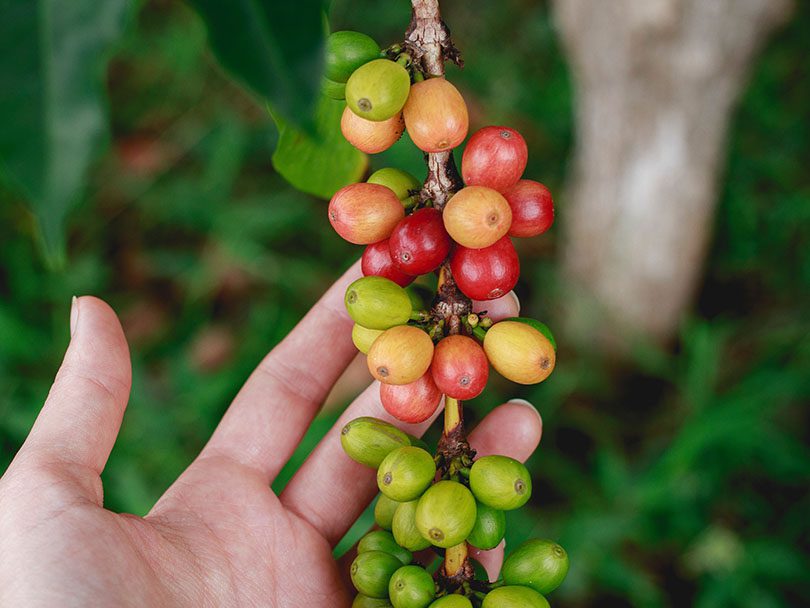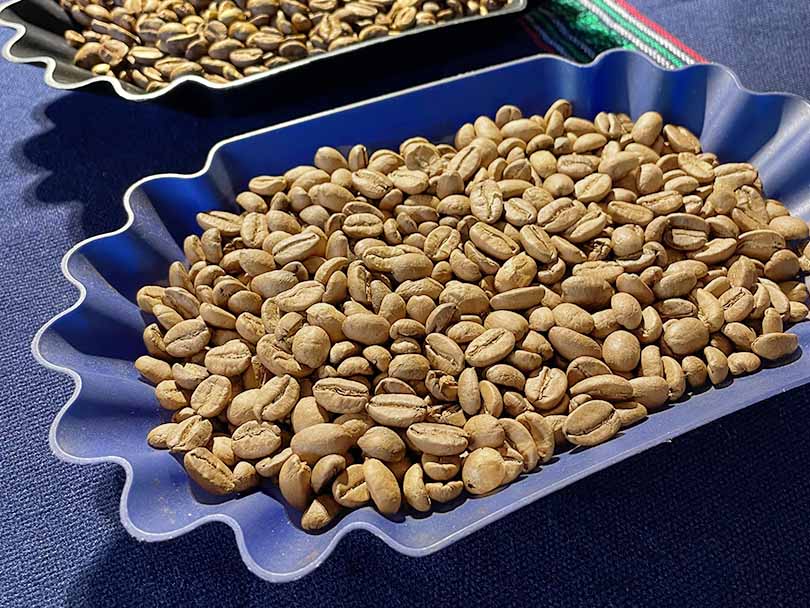Great coffee starts with the right soil and comes from many regions around the world but there are also many places that cannot grow coffee. So, what is the best soil for coffee plants? You will not be surprised to find that the countries that successfully grow and export coffee have a few things in common, including fertile, well-drained soil.
Two main types of soil are best for growing coffee plants, both of which come from volcanic regions. There are also a few conditions that you absolutely must avoid to grow healthy plants that yield excellent beans. I research single-origin coffees at Craft Coffee Spot and collaborated with Home Coffee Expert to understand what makes the best soil for coffee plants, so we can understand what makes the best types of coffee.
We’ll take a look at a few regions that grow the delicious coffee we all love. We’ll see how they use natural conditions that are optimal for coffee growing. Once we see what coffee plants need to grow and learn about some of the best coffee exporting regions in the world, we’ll look at how you might grow coffee plants at home.
This article may contain affiliate/ compensated links. As an Amazon Associate, we earn from qualifying purchases at no additional cost to you. For more information please see our disclaimer here.

DRAINAGE
Coffee plants need lots of oxygen in their roots. We often think that plants only need and take in carbon dioxide through their leaves. Isn’t that what we all learned in grade-school science? While this is still true, there is much more going on below the surface, especially where coffee plants are concerned.
Coffee plants need about three meters depth of well-drained soil to establish a solid root system. Heavy sandy or clay soils would be the worst for growing coffee plants because they would waterlog the roots. Soils that hold some water but drain well are better suited.
Many coffee-producing regions grow coffee plants on the sides of mountains. Not only do they have the type of soil good for the plants, but the angle of the slope helps with drainage.
Volcanic ash or loamy soils also provide more oxygen to the roots of coffee plants because they are porous. They have pockets that can hold water the plants need but also air. This gives the roots the right balance of oxygen and water.
NUTRIENT-RICH SOIL
Volcanic soils are best for coffee plants because they are rich in the nutrients the plants need. Think of this kind of soil as being “young” and full of nutrition. It has more recently come up out of the earth through volcanic activity.
The original minerals are still present because years of agriculture and erosion have not yet stripped away the minerals from the soil. Volcanic ash also tends to be particularly acidic, which coffee plants love.
ELEVATION
Arabica originated in the Highlands of Ethiopia. It has evolved to grow at relatively high altitudes and to get the best results many coffee-growing regions are at high altitudes. Coffee plants grow best at 1000-2000 meters above sea level.
TROPICAL CLIMATE
Many of the coffee-producing regions are located around the equator. We have all enjoyed coffees from South and Central America, Indonesia, and parts of Africa. The climate in these regions near the equator is perfect for coffee plant seedlings because there is frequent rain. Coffee plants need warmth and a lot of water to thrive.

Growing fresh ripe red coffee cherries to turn into the smooth, robust drink that we love is as much a science as an art. Much like growing grapes for wine, the soil content will affect the final product that we drink.
Some nutrients are the usual suspects for healthy plants. Among these are phosphorus, nitrogen, potassium, calcium, and zinc. How much or little of these elements and minerals are in the dirt will affect your cup of coffee. For example, the amount of potassium affects the sugar and citric content. The nitrogen level influences the amount of caffeine.
Volcanic soil is full of these nutrients, as well as lots of other compounds that are absorbed by the plants that can then be changed into complex flavor molecules in the fruit and seeds. Similar to other berries, tomatoes, and grapes, for example, coffee grown in volcanic soil can have a much more complex and interesting flavor profile.
It is little wonder that we can enjoy such varied flavor profiles from different places around the world. One of the things I love most about coffee is trying all the varieties to find my favorites. Each region has something new to offer us as coffee lovers.
Coffee can get up to 10 meters tall, but growers usually manage the coffee trees so that they are an optimal height for easy harvesting.
There are two main species of coffee plants grown for commercial use: arabica and robusta. You may have read these words on a coffee label in the past and wondered the difference. There are a few important differences that will become apparent as we discuss some famous coffee regions.
ARABICA
Arabica coffee plant varieties are high-quality. They produce fragrant and flavorful beans that we all enjoy so much. They grow best in the higher elevation range for coffee and at slightly cooler temperatures. The largest producer of arabica by volume is Brazil.
ROBUSTA
Robusta coffee plant varieties tend to produce beans that have a less complex flavor than arabica. Robusta is often used in instant coffees or blended with arabica to fortify the flavor. This variety can grow well in warmer climates than arabica as it evolved in lower altitude areas of modern-day Uganda. It is also more resistant to the main diseases that afflict arabica coffee plants. The main producers of robusta are Vietnam, Brazil, and Indonesia.
They have volcanic soil that has the acidity that coffee plants love. They have a tropical or sub-tropical climate that provides the warmth and frequent rain the coffee needs. They also grow their coffee at between 1000-2000 meters above sea level.
Higher elevations within that range will make for sweeter coffee beans. Ethiopian Yirgacheffe, for example, is quite sweet and grown at over 2000 meters above sea level. There tends to be slightly cooler temperatures farther above sea level, which contributes to the sweeter flavor.
These cooler temperatures cause the coffee cherries to ripen more slowly allowing build up of more complex flavor molecules within the berry. This is what leads to a higher quality of flavor from a high-altitude coffee bean tree.
Central American coffees provide a wide range of flavor types because there are several regions with different elevations. Lower elevations in Brazil produce strong, nutty, full-bodied coffees that are often used as espresso beans.
Hawaiian Kona beans have a bright, sweet flavor because the Hualalai region is at the higher range of altitudes for coffee growing.
Now I’ve mentioned a few of my favorite beans in this discussion so far. I love Kona and Ethiopian Yirgacheffe. We’ve talked about a few factors that contribute to the unique flavors of coffees from around the world. Let’s take a deeper look at a few regions and why they are famous for growing wonderful coffee.

CENTRAL AMERICA
Several Central American countries and regions grow fantastic coffee beans. From Brazil to Honduras to Guatemala, we have all enjoyed many great coffees from these counties. A newer bean that has been gaining popularity in recent years is Huehuetenango coffee from Guatemala. It has a sweet, slightly nutty, and chocolatey flavor.
What puts Guatemala in the top ten coffee-producing countries in the world? It has a combination of all that coffee beans need. It is located near the equator, so its climate is great for coffee plants. The coffee farms are located in the mountains between 1200 and 1700 meters above sea level. The elevation is ideal, and the near-daily rain drains well from the slopes mountains.
Most Guatemalan coffee that you are familiar with comes from the Antigua region. The coffee farms there are settled on the slopes of three volcanoes. The majority of beans grown there are the arabica varieties.
You can find out which country produces the most coffee here.
HAWAII
While coffee farms can be found in Hawaii, Texas, and California, the island state claims the prize for fitting all the categories that make for excellent coffee growing.
With a brilliant nutty aroma and flavor, Kona beans are a favorite among coffee lovers. They come from one specific region of Hawaii. Along the slopes of the Hualalai volcano, there is the perfect soil for growing coffee plants. The region also meets the needs for a tropical climate and elevation.
ETHIOPIA
Many coffee aficionados credit the country of Ethiopia in Africa as the birthplace of coffee. A fact that makes me eternally grateful to this country. It is also home to my personal favorite coffee bean Yirgacheffe. It is bright, floral, and fragrant!
Ethiopia has three distinct coffee regions, which are Yigacheffe, Harrar, and Ghimbi. The majority of all the beans are grown on small, private farms using no chemicals on the plants.
Ethiopia also has the triple crown of coffee growing with elevation, climate, and mountainside farms. The plants have perfect growing conditions with frequent rain and well-drained soil.
Think about where you live. What is the climate like? Would you be growing your coffee plants indoors or outdoors? If you live in one of the states that produce coffee, you can probably grow them outdoors. But if you plan to grow your coffee plants indoors, you may have more control over the factors at play.
SOIL
My guess is you don’t have a volcano in your backyard to provide you with fertile ashy soil perfect for coffee plants. That’s not a problem if you grow your plants in pots in your house or a greenhouse.
You can purchase coffee-growing potting soil easily online. An 8-quart bag will cost less than $20 to get started. The key here is to make sure that you are getting soil specific for growing coffee. Regular potting soil will not have the acidic properties best for growing coffee plants.
Some coffee potting soil brands add azomite dust to the soil in addition to the nutrients that are good for plants in general. The dust is from a mineral found in the Utah desert. It helps to emulate the soil nutrients found in the best coffee-growing regions.
WARMTH
Coffee beans come from tropical and African countries and regions because coffee plants need about 68 degrees Fahrenheit for optimal growth. You can easily simulate that temperature inside your home or a greenhouse if you live in a colder climate region.
WATER AND GOOD DRAINAGE
An aspect of the tropical climates that coffee plants love is almost daily rainfall. Coffee plants need lots of water with soil that drains well. You can recreate these conditions at home by purchasing the right kind of potting soil. The soil will help control the water flow, given that you are using a pot or container that allows the excess water out the bottom. Then you have to water your coffee plants daily.
Coffee enjoyment is also an artful hobby. While I don’t have one of the most sensitive palettes, I can still appreciate the subtle differences in coffees from different places. I love the light acidity and floral aroma of a hot cup of Ethiopian Yirgacheffe. Then I can also enjoy a robust, citrusy Sumatran coffee.
Unique soil gives each type of coffee a personality. We’ve learned that the best soil for coffee plant is volcanic ash. A close second is deep, loamy soil. The key is that there are nutrients such as potassium and nitrogen that affect the final flavor of the coffee. Acidic soil is good for coffee plants.
You can successfully grow coffee at home by simulating the conditions that we find in our favorite coffee-growing regions. You simply need the correct coffee plant soil temperature, water drainage, and warmth for the coffee plants to thrive. So get some little coffee cup planters and coffee plant seedlings and give it a go.

About the Author:
Marko Lazarevic is the founder of Craft Coffee Spot. He has been drinking craft coffee since stumbling upon a Kalita Wave during his first job. Since then, he has been trying new single-origin blends and different ways to brew coffee, and sharing the learnings through his brewing guides. His favorite brewing device is a French press.
You Might Also Like
-
What is Protein Coffee AKA Proffee?
Health Hack or Another Fad?We are fully in the “Protein Era” and nothing is safe. But what is protein coffee? Do we care? Should we care? Read all about Proffee here
-
What is White Coffee?
(Is It Just Another Coffee Fad?)If you’ve been wondering “What is White Coffee?”, you’re in the right place. (It’s not milk & coffee!) Learn about the caffeinated trend here


